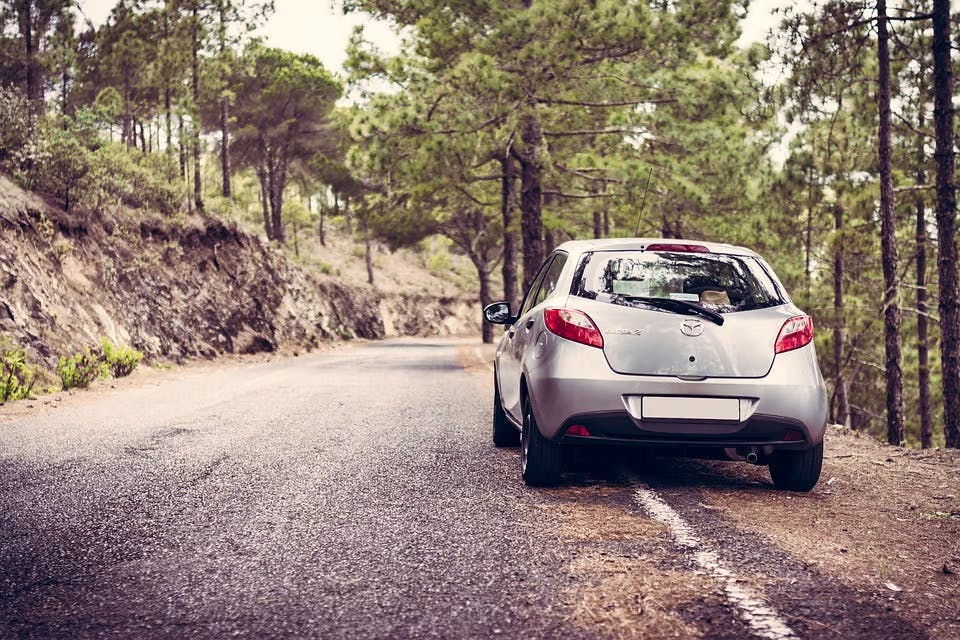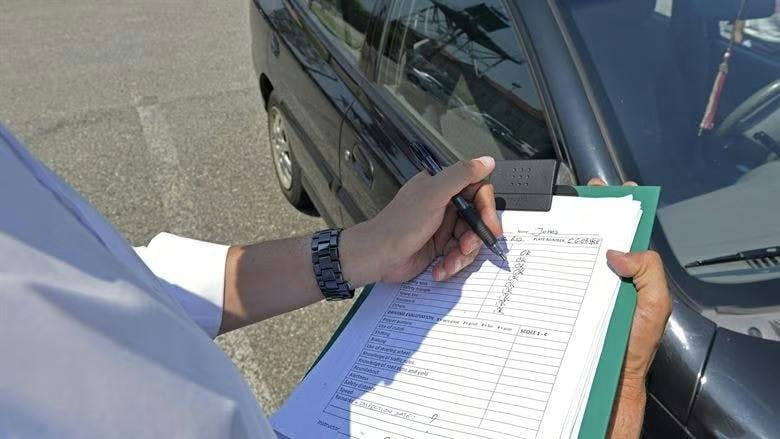
The practical test is a source of nerves for learner drivers across the UK—from the tricky 'show me, tell me' questions to the dreaded independent driving section. The part that seems to strike the most fear in learners, however, is manoeuvres. Practice makes perfect, however, and getting to know each manoeuvre off by heart can help keep you cool, calm and collected when it really counts. So, if you've not yet learned how to tackle the pulling up on the right manoeuvre, you've come to the right place!
In this guide, we're going to completely break down the pulling up on the right manoeuvre: how to perform it, what the examiner is looking for and when it might be used in real-life conditions.
What is pulling up on the right?
First added to the driving test in December 2017, the pulling up on the right manoeuvre is pretty straightforward. There are three main parts to this manoeuvre: pulling up on the right-hand side of the road, reversing for 2 car lengths and rejoining traffic.
Whilst the Highway Code advises drivers not to park against the flow of traffic, the DVSA notes that there are many real-life situations in which drivers may have to do so. As such, it's important that learners are taught how to perform the manoeuvre safely and correctly. There's a 1-in-3 chance that you'll be asked to complete this manoeuvre during your driving test. If you are asked to pull up on the right, it will sound something like this:
“Pull up on the right-hand side of the road when it's safe to do so...I'd now like you to reverse back for 2 car lengths, keeping reasonably close to the kerb.”
What is the examiner looking for?

The examiner will be assessing how safely the learner moves across the path of oncoming traffic and parks within a reasonable distance of the kerb. They'll be monitoring whether the learner, after stopping, applies the handbrake correctly and returns the gear lever to neutral. The examiner will also be watching for the learner's awareness of their surroundings as they reverse and move-off.
Throughout the manoeuvre, the examiner will be looking for:
- Careful observations: you need to use your MSM routines and show full awareness of other road users when pulling up on the right, reversing and rejoining traffic.
- Accuracy: you need to correctly position the vehicle throughout the manoeuvre and show confidence with doing so without instruction.
- Control: some of the manoeuvre will require you to move carefully and slowly, so you'll need to be on the ball and show careful planning and judgement.
You might accumulate driving test faults during this manoeuvre for incorrect use of controls and/or accuracy or not showing due regard for oncoming traffic.
If another vehicle pulls up behind your vehicle, preventing you from reversing back, then you won't be able to complete the manoeuvre. In this situation, the examiner will ask you to keep on driving and get you to carry out another manoeuvre later in the practical.
If a vehicle pulls up in front of your vehicle, then you'll still be able to carry out the manoeuvre. If it blocks your view, the examiner may take control of the situation and offer appropriate advice.
Step-by-step: How do I pull up on the right?
1. Find a suitable location to pull up
The examiner will only tell you to pull up on the right when it's safe to do so. As such, it will be entirely down to you to pick a spot at which to pull up. Don't panic and simply choose the first empty spot you can find—instead, apply the same principles as you would when pulling up on the left. We'd recommend that you look for a large space that will give you plenty of room to get your vehicle straight next to the kerb.
- If it's a tight road, you don't want to pull up across from parked vehicles—it will make it much more difficult for you to rejoin traffic.
- Try to avoid blocking driveways where you might get in the way of drivers entering or leaving. If you have to, however, you are allowed to do so for this manoeuvre.
- You'll want to avoid pulling up too closely to junctions, bends or bus stops, as you might end up causing an obstruction or an accident if visibility is limited.
- If you can, try not to pull up behind another vehicle—it will block your view of oncoming traffic when you need to rejoin the road.
2. MSM and correct positioning
Once you've got a spot picked out, it's important that you use the MSM (Mirrors, Signal, Manoeuvre) routine to safely move towards the right.
- Look at your interior mirror, check your right-hand mirror and follow up with a check of the blindspot over you right shoulder. If it's all clear, signal to the right.
- Position your vehicle to the right-hand side of your lane, as if you were making a right turn at a junction.
- It's important not to rush here—wait and see if you need to give way to oncoming traffic. If you have to wait, check your mirrors again. You never know what might have changed!
- Once it's clear, give your mirrors another quick check and be sure to check your right shoulder blindspot again.
3. Pull up on the right
As a rule of thumb, it's advised that you leave around 8 car lengths from where you've stopped to give way to oncoming traffic to where you intend to pull up. This will give you plenty of room to manoeuvre and straighten up your vehicle.
- When it's safe to pull up on the right, try to move in at a shallow angle. If you try it at a steep angle, you're more likely to hit the kerb, and you'll also have more trouble getting your vehicle parallel to the kerb.
- You need to get relatively close to the kerb—around 20-30 cm away. Your instructor will have likely given you reference points for pulling over, e.g., “You'll be parallel once the side of the kerb meets the car's windscreen.”
- Try to get the vehicle parallel to the kerb and straighten the wheels before you stop. By doing so, you'll make things easier for yourself when you have to reverse.
- Stop the car, put the handbrake on and select the neutral gear.
4. Reverse and move off
Once you've stopped the car, the examiner will then asked you to reverse back for approximately 2 car lengths. If you've done as we advised and stopped parallel with the kerb, this should be a piece of cake.
- Start by selecting the reverse gear. Before you start moving, you need to make sure there's no oncoming traffic. If there is, wait for the vehicles to pass.
- Now it's time for mirror and blind spot checks. Work in an anti-clockwise movement—check your right shoulder blindspot, right-hand mirror, interior, left-hand mirror, left shoulder blindspot and then the rear window.
- Keep an eye on the rear window as you reverse, continuously looking in all directions for other road users. If you have to stop for pedestrians or cyclists, for example, you'll have to do your checks all over again.
- Keep your reference point in mind and line up with the kerb as you reverse. Once you've moved 2 car lengths, stop the car, apply the handbrake and select neutral. The examiner will tell you when to move off.
- Once you're ready to do so, select first gear and do your checks. Look at your interior mirror, check the left-hand mirror and look at your left shoulder blindspot. Check for oncoming traffic and if it's all clear, signal left and move off.
And there you have it! It might seem pretty complicated at first, but once you break it down, it's as easy as pie.
When should this be used in real life?
Whilst the best practice is to pull up on the left, there will undoubtedly be circumstances during your driving life in which you'll have to settle for pulling up on the right instead. After all, it's not always possible to pull up on the left.
Here are a few example situations in which pulling up on the right might be your best bet:
- When there are parking spaces on the left and right, but the left-hand side is completely full.
- If there are single or double yellow lines on the left and parking spaces on the right-hand side.
- When there are disabled parking spaces available on the right-hand side of the road.
- When there are driveways on the left-hand side and shops to the right-hand side with available space.
FAQs
Is it legal to pull up on the right?
Although it's not recommended by the Highway Code, it is perfectly legal to pull up on the right. The DVSA consulted with the Association of Chief Police Officers (ACPO) and The Royal Society for the Prevention of Accidents (ROSPA) before deciding to include the manoeuvre on the new driving test. If you're learning with an instructor, they'll be sure to advise you of when you should and shouldn't do so.
Can I refuse to complete the pulling up on the right manoeuvre?
If you want your test to go ahead, you won't be able to refuse to complete any manoeuvre the examiner asks you to carry out. You can ask questions if you feel like you might encounter problems by doing so, but refusing outright will likely lead to the examiner terminating the test.
Where will I be asked to carry out the manoeuvre?
You could be asked to carry out this manoeuvre anywhere. The examiner isn't limited to quiet roads and they're also not told to do it on the busiest road possible. It's in their best interest to keep the practical test going on time, so it's unlikely that they'll pick a congested area.
Isn't it dangerous to pull up on the right during winter or at night if you've got your headlights on?
It's certainly true that pulling up on the right can be dangerous during winter or at night—you run the risk of your headlights blinding oncoming traffic. However, just like you need to know how to safely drive at night, you also need to know how to safely carry out this manoeuvre.
What if another vehicle pulls up in front of me when I've stopped on the right-hand side?
In this case, the manoeuvre will continue as you'll still be able to reverse back. When you're moving to rejoin traffic, you'll have to be careful as the vehicle in front of you might be blocking your view of oncoming traffic.
What if another vehicle pulls up behind me when I'm supposed to reverse back?
In this situation, you won't be able to complete the manoeuvre. Instead, the examiner will tell you to drive on and ask you to complete another manoeuvre later on in the driving test.
What should I do if I think I'm going to hit the kerb?
You are allowed to make adjustments during your manoeuvre, so don't wait until it's too late—you'll get a serious driving test fault if you hit the kerb. Keep making your adjustments and re-adjust until you're straight and parallel with the kerb.
Will the examiner get out to check if I'm too close/far from the kerb?
It's unlikely that the examiner will have to get out of the car to check whether you've lined up close enough to the kerb. They've probably been doing it long enough to be able to tell just from inside of the car.
What if I can't pull up on the right when it's safe to do so?
It's up to you to choose a place to pull up on the right. If you keep on driving for too long and it becomes clear that you're unable to carry out the manoeuvre, the examiner will take control. They'll issue a verbal command, either repeating the instruction again or aborting the manoeuvre so it can be carried out later in the test.
How long is two car lengths?
Given that standard parking spaces are around 15.7ft (4.8m) in length, two car lengths would come in at around 31.4ft (9.6m). The examiner, of course, does not expect you to be so specific—they're not going to get out and measure how far you've reversed. If you struggle with this part of the manoeuvre, we'd advise you pick out a reference point, such as a lamp post or a tree, to help give you an idea of how far back to reverse.
What if I reverse only one car length, or more than two car lengths?
Your driving examiner's judgement will come into play here. If they don't think you've reversed far enough, then they'll likely advise you to continue reversing. If, on the other hand, you reverse further than you needed to, they probably won't mention it—as long as you stop, of course, and don't continue reversing! In either case, it's unlikely that you'll fail.
What are the chances that I'll be asked to complete this manoeuvre?
There's a 1-in-3 chance that you'll be asked to complete the pulling up on the right manoeuvre. As such, you need to make sure that you know how to demonstrate it safely and confidently. Don't ignore it in the hopes that you'll be asked to complete one of the other manoeuvres!
What other manoeuvres are there?
Other than pulling up on the right, there are two other manoeuvres that you could be asked to complete on the driving test:
- Parallel parking at the side of the road
- Bay parking—either driving into a parking space and reversing out, or reversing into a parking space and driving out.
What if there's a lot of oncoming traffic for a long period of time?
If there's no opportunity for you to turn right, due to heavy oncoming traffic, the examiner might ask you to cancel the manoeuvre and continue driving— you'll be asked to complete the manoeuvre later in your test. If, on the other hand, you could have moved off during a break in the traffic—but you chose not to—the examiner might give you a driving test fault for undue hesitation.
When in the test will I be asked to perform this manoeuvre?
You can be asked to demonstrate one of the three manoeuvres at any point during the independent driving section. There's no set time specified by the DVSA, so it's entirely up to the examiner to decide. As such, there's no real way of you predicting exactly when you'll be asked. Instead of dwelling on it, we'd suggest you just concentrate on your driving and take it one step at a time.
Subscribe for driving advice, offers & more
We'd love to let you know about our courses, news and offers via email. You may unsubscribe at any time.
Star Genie Limited trading as PassMeFast. Company number 10093359
Copyright © 2024 owned by Star Genie Limited
PassMeFast, Blue Tower, MediaCityUK, Salford, M50 2ST
